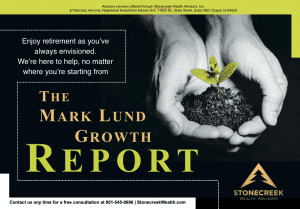
Recessions Are Hard To Call, But We Know What Comes After
In the movie Being There, Peter Sellers plays a simple-minded gardener called Chauncey who is accidentally swept up into a circle of high influence in Washington, D.C. Everyone he meets mistakes his blank expression for an intent interest in what they have to say. And his simple statements about the basics of gardening are taken as deep wisdom.
When the President asks Chauncey his advice about the economy, Seller’s character answers, “In the garden growth has its seasons. First comes spring and summer, but then we have fall and winter. And then we get spring and summer again.”
The President replies, “That is one of the most refreshing and optimistic statements I’ve heard in a very long time.” (1)
It’s an amusing scene, yet like all great comedy is at least 95% true. When we look back at the market’s performance in the second quarter and wonder about what might lie ahead, Chauncey’s line about the seasons following one another makes quite a bit of sense.
After 2022’s economic winter, investors have spent the first half of 2023 looking for any signs of spring. High inflation, repeated interest rate hikes, labor shortages, and other factors have created an environment that’s been hostile to growth. Yet late in the quarter we are beginning to see signs that these economic headwinds are beginning to die down.
The financial pundits have been filling their allotted airtime with daily speculation about which way the economy is headed. Some have been cautiously optimistic. Some have been pessimistic. But as usual, the doomsayers have a much more riveting story and often a book to sell and so more often get the headlines.
As much as we all want to know right now how the economy is doing and which way it is headed, official assessments by real economists take time. A trove of diverse data must be analyzed and often the bellwethers we took for a fact a few months ago turn out to have been misleading.
Because of this lag time, we can never know if we are in a recession today. Take for example the economic downturn of 15 years ago. The official announcement that the economy was indeed in a recession came in December 2008—a year after the recession had actually started. By then stock prices had dropped more than 40%. And although that recession ended in May 2009, the announcement came 16 months later, by which time U.S. stocks had rebounded. (2)
However, even though we might not know the direction the economy is headed at any given moment, we do know that just as spring follows winter recoveries follow recessions.
Dimensional recently did a study of post-recession returns for the 75 year period beginning in 1947, the first year that U.S. gross domestic product data was calculated on a quarterly basis. (Note: there have been 12 official recessions during this period.) The analysts looked specifically at the 1-, 3-, and 5-year returns of the S&P 500 after the recession start dates.
They found that over this period the average 1-year return immediately following a recession was 6.4%. The 3-year average was 43.7%. And the 5- year was 70.5%.
As you might expect, the 1-year return is about half the average for all months of that period. But surprisingly, the 3-year return is 1% higher than the average. This is because after a downturn the market tends to enter a period of growth.
Chauncey from Being There was more right than he knew. The market is in many ways like a garden. Its growth is the result of innumerable complex processes, some of which are not fully understood.
Consider the massive amounts of information stored in a single bean seed. Once placed in dirt, it senses when to sprout. It knows how to collect water and nutrients from the soil. It directs its growth directly against the force of gravity, while angling its leaves for maximum sunlight. It lures in bees to pollinate its blossoms. And then it makes hundreds of copies of itself.
The good news is that you don’t need a PhD in botany to grow a bean plant. You just poke a seed into some moist topsoil. A four year old can do it. And that’s similar to investing in the market. You don’t need to understand its mind- numbing complexities for it to work for you.
Of course a master gardener can help you maximize your bean yield. Or if you’re impatient, warn you against digging up your seeds to see if they are sprouting. A trusted advisor can help you in similar ways with your investments.
Also like a garden, the market will have seasons where things aren’t going to grow very well or maybe not at all. But these have always passed. And the prudent investor realizes that because he or she cannot predict when the market will enter a period of recovery, the only chance of benefiting from those unexpected big days is to have their money in the market.
In other words, you can miss out on the growing season when you don’t have your seeds in the ground.
If you ever have any questions about your investments or retirement plans, please feel free to give me a call at 801-545-0696.
Regards,
Mark Lund
Stonecreek Wealth Advisors, Inc.
11576 S State Street, Bldg. 1002
Draper, UT 84020
Sources:
1. https://www.imdb.com/title/tt0078841/characters/nm0000634
2. http://elink.dimensional.com/m/1/62855187/02-b23156- ab54fdf6dcce49108472a6224b1dd78e/1/75/9b9c6736-3673-4677-b6df- b0f554dc1ed9
Disclosure: This information should not be construed as investment, tax or legal advice and may not be relied on for the purpose of avoiding any Federal tax penalty. All information is believed to be from reliable sources; however we make no representation as to its completeness or accuracy. All economic and performance data is historical and not indicative of future results. Market indices discussed are unmanaged. Investors cannot invest in unmanaged indices. The publisher is not engaged in rendering legal, accounting or other professional services. If assistance is needed, the reader is advised to engage the services of a competent professional. This material was prepared by Efficient Advisors, LLC (“EA’) for Mark Lund, Mark is a Financial Advisor in Utah. He is known as a Wealth Advisor, The 401k Advisor, Investor Coach, Financial Planner, Investment Advisor and author of The Effective Investor. Mark offers investment advisory services through Stonecreek Wealth Advisors, Inc. a fiduciary, independent, fee-only, Registered Investment Advisor firm providing investment management and retirement planning for individuals and 401k consulting for small businesses. Mark’s newsletter is called The Effective Investor Newsletter. Cities served in Utah are: Salt Lake City, Salt Lake County, Utah County, Park City, Murray City, West Jordan City, Sandy City, Draper City, South Jordan City, Provo City, Orem City, Lehi City, Highland City, Alpine City, American Fork City. The views expressed herein are exclusively those of Efficient Advisors, LLC (‘EA’), and are not meant as investment advice and are subject to change. All charts and graphs are presented for informational and analytical purposes only. No chart or graph is intended to be used as a guide to investing. EA portfolios may contain specific securities that have been mentioned herein. EA makes no claim as to the suitability of these securities. Past performance is not a guarantee of future performance. Information contained herein is derived from sources we believe to be reliable, however, we do not represent that this information is complete or accurate and it should not be relied upon as such. All opinions expressed herein are subject to change without notice. This information is prepared for general information only. It does not have regard to the specific investment objectives, financial situation and the particular needs of any specific person who may receive this report. You should seek financial advice regarding the appropriateness of investing in any security or investment strategy discussed or recommended in this report and should understand that statements regarding future prospects may not be realized. You should note that security values may fluctuate and that each security’s price or value may rise or fall. Accordingly, investors may receive back less than originally invested. Investing in any security involves certain systematic risks including, but not limited to, market risk, interest-rate risk, inflation risk, and event risk. These risks are in addition to any unsystematic risks associated with particular investment styles or strategies.







